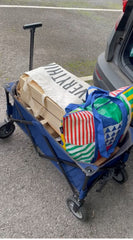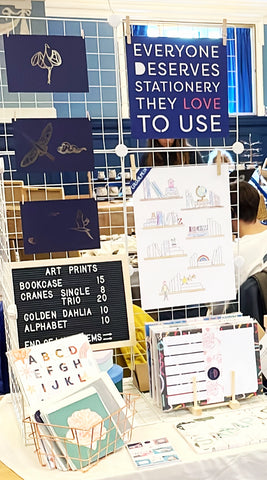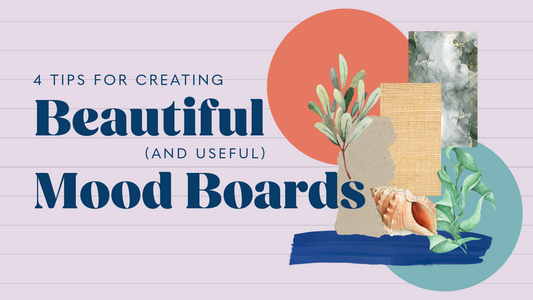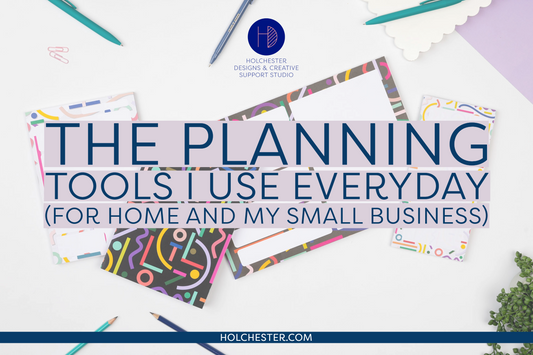Getting ready to sell your products at a market can feel very overwhelming.
Especially if it’s a festive one where you might feel extra pressure to look festive and hit some targets.
I can’t claim to be a pro at market prep, in fact it’s only been the past 2 years or so post-pandemic that I’ve started to embrace them. But actually it’s because of that I thought this might be a good post to write as the lessons I’ve learned are still pretty fresh!
So these are the 5 areas I think that, if you prepare properly, mean you can feel comfortable, confident and enjoy the day.
What stock to take
Trust me I’ve looked but I still can’t find a calculation that helps plan how much stock to take. And I don’t think I’ve ever got it spot on! But these are the questions I now ask myself to help me gauge it:

HOW MUCH CAN YOU CARRY - How far have you got to travel and pull/carry your stock. It’s the biggest limiting factor and it’s much better to work with it then against it, especially for on-the-day stress levels. (FYI I’ve got a little wheely wagon I can pull around with me and it’s hand-down the best thing I’ve done for markets).
HOW MUCH ££ DO YOU WANT TO TAKE - What will cover my time, stall cost, and travel and give me some left over. You can’t predict exactly what will sell, but if you’re aiming for £200 then taking £500 of stock is probably a heavy way of being ready.
KEY PRICE POINTS - Making sure I have items that clearly hit price points e.g. under £10, Gift sets £15-20, little uplifts etc.
BE STRATEGIC - The gift sets I sell at markets are only made up of combining individual products (no little extras like I might online), so I plan my individual stock of items for markets with the intention that they’ll double up for gift sets too (as long as I remember to pack the ribbons to wrap them together with!).
What your stand should look like

There’s a few things I make sure I ‘hit’ to feel confident standing next to my stand (and not hidden behind it).
HEIGHT – Make the most of the real estate you’ve paid for by using the height. It gives you more space to display your items, and lets you be creative in doing so too. Plus when you’ve got a crowd in front of you, people walking past can still have their eyes caught.
BRANDING – Keep it consistent. From the colour of your table cloth, the writing on your labels, the stamps on paper bag and the cards/flyers you give them with their purchase, keep it on brand. All of these create a common thread that’ll take someone from their experience at your stall through every touch point with your business. And when added together it’ll reaffirm your brand and helps it lodge in their memory.
CLEAR PRICING & LABELLING – don’t presume that because you’re lovely your potential customer will ask. Elinor Perry from Biddy & Bear recommends pricing every item unless it’s really obvious which product is which as if there’s any ambiguity “people won’t ask.”
PERSONALISED/NON-PERSONALISED – Another great tip from Biddy & Bear’s Elinor is to be clear if you can take personalised orders on the day. “Be clear about turnaround times and try to take payment on the stall - don’t rely on customers to come back later.” Plus maximise them being there by having plenty of non-personalised items available they can take away on the day too.
TELL YOUR STORY – I don’t mean literally but can you have any props/materials around your stall that tells customers a bit more about you? Obviously it depends on your business but examples are things like images of you at work to demonstrate something’s handmade or a piece of raw material that can contrast with an item you make and sell. This could also be a great way of being on brand and adding festive touches to your stall as well!
What to say
START WITH A SMILE - It’s simple but keep smiling and say hello to everyone. A ‘hello’ isn’t pushy, but it is polite and is a great way of judging how much interaction someone might be comfortable with. A small positive interaction may not result in an immediate sale, but it’s the best starting point to building a rapport with someone.
KNOW YOUR BENEFITS - Melissa Reynolds-Lawrence from Honey Bee Home gave me a brilliant tip for getting a conversation going and converting it:
“Think of one benefit of each product, or category of products. “[something like] I love this reed diffuser, it lasts ages”. Things may look nice but knowing how it will add value to their life, even in a small way, is what will draw [people] in”.
PREPARE SOME CONVERSATION STARTERS – A few talking points can help mix things up a bit. For example I now always have a sample on my stall I can offer people to write on to try out the paper quality or pick up to flick through. Ask them if they’re local or have come far, if there’s someone in mind who might like stationery etc. They don’t have to be nosey questions but can be great for getting people chatting without too much pressure.
YOU’RE NOT REPEATING YOURSELF – Actually you probably are, but it’s not all to the same person so don’t worry about it!
What practical things to take
Quick checklist for you:
*Card Reader and small sign to say you take cards/cash
*Power packs for devices, and all the various cables you’ll need.
*Masking/Low-tack tape (you never know when you might need to reattach something or keep something out the way.) Also potentially useful are string, scissors, ribbon and/or pegs.
*Business cards and flyers – always have something people can take away with them. And possibly a code too which you can give them to entice them to spend with you at another time.
*QR code or list for collecting email addresses (have you got a lead magnet you can tell them about too?!)
*Nice bags (if you offer them).
*Water bottle and some snacks. (If it’s cold a decent flask filled with hot Ribena makes a perfect afternoon pick-me-up without needing any milk etc).
*Notebook and pen – Have it at the ready for scribbling down any comments you overhear, things you chat about or ideas that might come to you for future products or marketing. It’s a busy day so don’t presume you’ll remember it all.
Market Day Mindset preparation
I’m undecided about whether this part should actually have come first because, for me, mindset really is a crucial foundation. But if I could give only one piece of advice it would be this:
Sales alone are not the only sign of a successful market day.
Obviously sales are important - my bank account and I are well aware of that - but there’s so much more you can get from a market. Sign-ups to your email list are one thing, as is constructive feedback and discussion topics from people who have stopped by and looked/chatted (that’s exactly what that notepad’s for!). Not everyone can, or is willing to, buy at first sight and that is absolutely no reflection on your products, your business or you. But they may say something that would make a fantastic blog post or topic for a social media caption!
At the same time though don’t be afraid of selling – you’re not an icky 90s-style second car salesperson. You’re actually an expert in what you do and what you provide can both help people out and bring them joy. They’re lucky to have found you!
If it is a slow market day, and sometimes an event isn’t a great fit for various reasons, try your best to remain objective, reserving full-judgement until you’re all packed up, on the way home and can reflect without distractions.
Finally, regardless of how it ‘feels’ like it went try and analyse the data you’ve got when you get home, good and bad. What sold well, what received lots of comments, was there anything that with hindsight felt priced wrongly or that could be more competitive. As a small business owner it’s often hard to separate a response to your business from it feeling personal, so using the data is a great way of getting that separation. One thing I’ve learned from Catherine Erdly at The Resilient Retail Club is just how much data we have available to us. Once we take a step back and look more objectively for it, there’s just so much we take from it.
I realise this post has got loooooong but I really hope it’s helped you prepare, or given you a few things to think about at least. Each market and fair is very much it’s own beast, with so many variables at play, but if you can be practical and objective in the preparation then you really can feel comfortable and confident in you and your business on the day.



